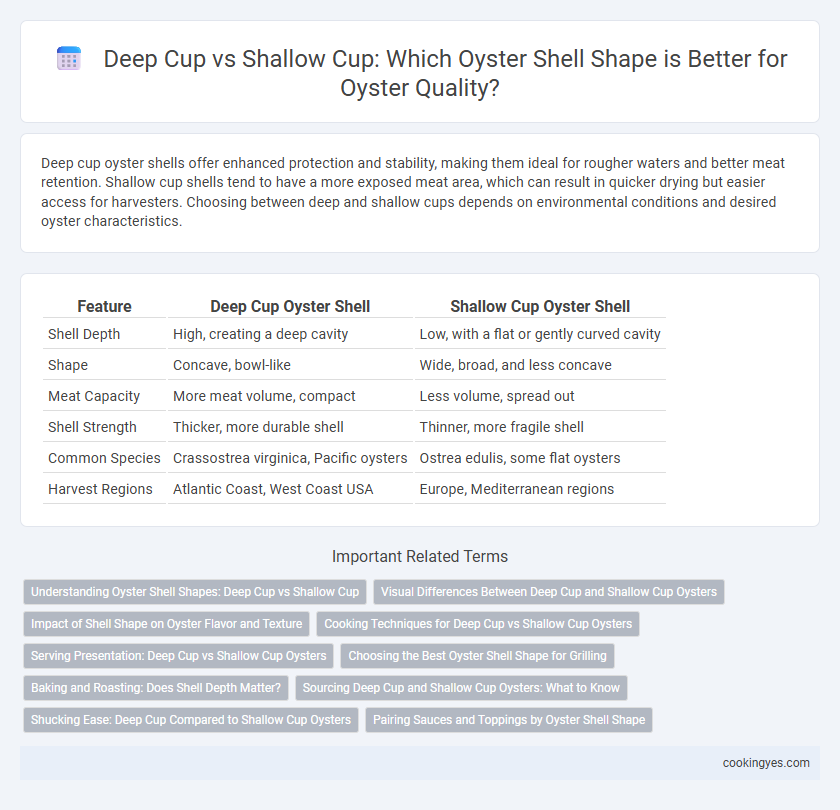Deep cup oyster shells offer enhanced protection and stability, making them ideal for rougher waters and better meat retention. Shallow cup shells tend to have a more exposed meat area, which can result in quicker drying but easier access for harvesters. Choosing between deep and shallow cups depends on environmental conditions and desired oyster characteristics.
Table of Comparison
| Feature | Deep Cup Oyster Shell | Shallow Cup Oyster Shell |
|---|---|---|
| Shell Depth | High, creating a deep cavity | Low, with a flat or gently curved cavity |
| Shape | Concave, bowl-like | Wide, broad, and less concave |
| Meat Capacity | More meat volume, compact | Less volume, spread out |
| Shell Strength | Thicker, more durable shell | Thinner, more fragile shell |
| Common Species | Crassostrea virginica, Pacific oysters | Ostrea edulis, some flat oysters |
| Harvest Regions | Atlantic Coast, West Coast USA | Europe, Mediterranean regions |
Understanding Oyster Shell Shapes: Deep Cup vs Shallow Cup
Deep cup oyster shells feature a pronounced concave shape that creates a protective basin, ideal for holding more oyster meat and preserving flavor during harvest. Shallow cup oyster shells have a flatter profile with less depth, allowing faster growth but often resulting in thinner oyster meat. Understanding these shell shapes aids in selecting oysters optimized for taste, texture, and culinary use.
Visual Differences Between Deep Cup and Shallow Cup Oysters
Deep cup oysters have a pronounced, concave shell that creates a deep basin, giving them a robust and rounded appearance. Shallow cup oysters feature a flatter, more open shell with a less curved surface, resulting in a broader and more delicate look. The visual distinction is evident in the depth and curvature of the shell, influencing the oyster's presentation and the amount of liquor it holds.
Impact of Shell Shape on Oyster Flavor and Texture
Deep cup oyster shells create a protected environment that allows for more briny, intense flavors and a plump, tender texture, favored by gourmets seeking a rich taste profile. Shallow cup oysters tend to have a milder, sweeter flavor with a firmer texture due to increased exposure to varying tidal conditions and faster water flow. Shell shape influences water retention and nutrient absorption, directly impacting the oyster's flavor complexity and mouthfeel.
Cooking Techniques for Deep Cup vs Shallow Cup Oysters
Deep cup oysters, with their deep, rounded shells, excel in cooking techniques like grilling and broiling, where the shell acts as a natural bowl retaining juices and flavors. Shallow cup oysters, having flatter shells, suit quick-cooking methods such as frying or baking, allowing even heat exposure and crisp texture development. Understanding the shell shape enhances cooking outcomes by optimizing heat distribution and moisture retention for each oyster type.
Serving Presentation: Deep Cup vs Shallow Cup Oysters
Deep cup oysters offer a stable base and retain more brine, enhancing flavor and presentation on the half shell. Shallow cup oysters provide a sleek, elegant look, ideal for plating and pairing with delicate garnishes. Choosing between deep and shallow cups impacts both visual appeal and the intensity of the oyster tasting experience.
Choosing the Best Oyster Shell Shape for Grilling
Deep cup oyster shells retain more brine and natural juices during grilling, enhancing flavor and moisture, while shallow cup shells tend to cook faster but may lose more liquid. Opting for deep cup oysters ensures a juicier, more flavorful result on the grill, preserving essential oyster characteristics. The strategic choice between deep and shallow cup shells directly impacts grilling outcomes, balancing tenderness and taste.
Baking and Roasting: Does Shell Depth Matter?
Deep cup oyster shells provide better heat insulation during baking and roasting, preserving the oyster's natural juices and enhancing flavor. Shallow cup oysters tend to cook faster but risk drying out due to their increased surface exposure. Choosing deep cup oysters ensures a juicier, more tender texture when subjected to high heat cooking methods.
Sourcing Deep Cup and Shallow Cup Oysters: What to Know
Sourcing deep cup and shallow cup oysters requires understanding their distinct shell shapes and flavor profiles, which affect texture and brininess. Deep cup oysters, with their rounded, concave shells, typically hold more liquor and offer a saltier, richer taste, making them favored for fresh consumption. Shallow cup oysters, featuring flatter shells, tend to have a milder flavor with a firmer texture, often sourced from calmer waters where shell development is influenced by environmental factors.
Shucking Ease: Deep Cup Compared to Shallow Cup Oysters
Deep cup oysters, characterized by their concave and thicker shells, often present more challenges during shucking due to the increased shell depth and stronger adductor muscle attachment. In contrast, shallow cup oysters have flatter shells with a thinner profile, allowing for easier and quicker shucking with less risk of shell fragments. The shallow cup shape optimizes handling efficiency for shuckers by reducing the effort required to pry open the oyster and extract the meat safely.
Pairing Sauces and Toppings by Oyster Shell Shape
Deep cup oysters hold richer, brinier flavors that pair exceptionally well with bold, acidic sauces like mignonette or horseradish-based toppings, which enhance the oyster's natural depth. Shallow cup oysters offer a lighter, sweeter taste profile, making them ideal for delicate pairings such as citrus vinaigrettes or cucumber garnishes that complement rather than overpower. Selecting sauces and toppings based on the oyster shell shape intensifies the overall tasting experience by aligning flavor strength with the oyster's inherent character.
Deep Cup vs Shallow Cup for oyster shell shape Infographic

 cookingyes.com
cookingyes.com